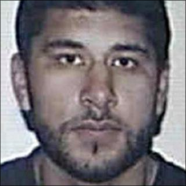Overview
Hasib Hussain was one of four suicide bombers in the coordinated London bombings on July 7, 2005, known colloquially as the 7/7 bombings.“7 July London Bombings: What Happened that Day?” BBC News, July 3, 2015, http://www.bbc.com/news/uk-33253598;
“7/7 London bombings: What Happened on 7 July 2005?” BBC, July 6, 2015, http://www.bbc.co.uk/newsround/33401669. At 18 years old, Hussain was the youngest member of the al-Qaeda-linked terror cell responsible for the attack, which included 7/7 bombers Mohammad Sidique Khan, Germaine Lindsay, and Shehzad Tanweer. Hussain carried out his suicide bomb attack on a double-decker bus in London’s Tavistock Square, killing 13 people.“7/7 Bombings: Profiles of the Four Bombers Who Killed 52 People in the London Attacks,” Independent (London), July 6, 2015, http://www.independent.co.uk/news/uk/home-news/77-bombings-london-anniversary-live-profiles-of-the-four-bombers-who-killed-52-people-in-london-10369984.html;
“July 7 2005 London Bombings Fast Facts,” CNN, last updated July 29, 2016, http://www.cnn.com/2013/11/06/world/europe/july-7-2005-london-bombings-fast-facts/. In total, the 7/7 bombings constituted the deadliest modern terrorist attack on British soil, collectively killing 52 people and wounding more than 770 others.Laura Smith-Spark, “7/7 Anniversary: UK Remembers Those Lost in 2005 London Terror Attacks,” CNN, July 9, 2015, http://www.cnn.com/2015/07/07/europe/uk-london-terror-attack-anniversary/;
“7/7 London bombings: What Happened on 7 July 2005?” BBC News, July 6, 2015, http://www.bbc.co.uk/newsround/33401669. Al-Qaeda claimed responsibility for the bombings in a video released in September 2005.Alan Cowell, “Al Jazeera Video Links London Bombings to Al Qaeda,” New York Times, September 2, 2005, http://www.nytimes.com/2005/09/02/world/europe/al-jazeera-video-links-london-bombings-to-al-qaeda.html?_r=0.
Hussain was the youngest of four children, born in 1986 to Pakistani immigrants and raised in Holbeck, a suburb of Leeds in West Yorkshire, England.“Profile: Hasib Hussain,” BBC News, March 2, 2011, http://www.bbc.com/news/uk-12621387. Hussain reportedly showed signs of extremism dating back to September 2001 when, following al-Qaeda’s 9/11 attacks in the United States, Hussain passed two fellow students a note, ominously saying, “You’re next.”“7/7 Bombings: Profiles of the Four Bombers Who Killed 52 People in the London Attacks,” Independent (London), July 6, 2015, http://www.independent.co.uk/news/uk/home-news/77-bombings-london-anniversary-live-profiles-of-the-four-bombers-who-killed-52-people-in-london-10369984.html. In the subsequent years, Hussain would speak openly of his support for Islamic extremists, often referring to al-Qaeda’s 9/11 bombers as “martyrs.”“Profile: Hasib Hussain,” BBC News, March 2, 2011, http://www.bbc.com/news/uk-12621387. At some point in 2001, Hussain met and befriended fellow extremist Mohammad Sidique Khan at a mosque in nearby Beeston.“7/7 Bombings: Profiles of the Four Bombers Who Killed 52 People in the London Attacks,” Independent (London), July 6, 2015, http://www.independent.co.uk/news/uk/home-news/77-bombings-london-anniversary-live-profiles-of-the-four-bombers-who-killed-52-people-in-london-10369984.html. Khan, who would later be considered the ringleader of the 7/7 terrorist cell, introduced Hussain to his network of fellow Islamic extremists, including Khan’s “right-hand man” and fellow 7/7 organizer Shehzad Tanweer.“Profile: Mohammad Sidique Khan,” BBC News, April 30, 2007, http://news.bbc.co.uk/2/hi/uk_news/4762209.stm;
Esther Addley, “7/7 Ringleader Tried to Convert Schoolboy to Radical Islam,” Guardian (London), February 14, 2011, https://www.theguardian.com/uk/2011/feb/14/7-7-ringleader-radical-islam-inquests;
“7/7 Bombings: Profiles of the Four Bombers Who Killed 52 People in the London Attacks,” Independent (London), July 6, 2015, http://www.independent.co.uk/news/uk/home-news/77-bombings-london-anniversary-live-profiles-of-the-four-bombers-who-killed-52-people-in-london-10369984.html.
In early 2002, Hussain and his family traveled to Saudi Arabia to perform the Hajj, the Islamic pilgrimage from Mecca to Medina, and then traveled to Pakistan to visit relatives. Upon the family’s return to England, Hussain reportedly became more outwardly religious, beginning to grow a beard and don traditional Islamic dress.“Profile: Hasib Hussain,” BBC News, March 2, 2011, http://www.bbc.com/news/uk-12621387;
“7/7 Bombings: Profiles of the Four Bombers Who Killed 52 People in the London Attacks,” Independent (London), July 6, 2015, http://www.independent.co.uk/news/uk/home-news/77-bombings-london-anniversary-live-profiles-of-the-four-bombers-who-killed-52-people-in-london-10369984.html. At some point following his return to the United Kingdom, someone noticed that Hussain had written “Al Qaeda - No Limits” on one of his religious school workbooks.“Profile: Hasib Hussain,” BBC News, March 2, 2011, http://www.bbc.com/news/uk-12621387.
By 2004, Hussain had reportedly signed on to Khan’s terrorist mission, though Khan had not yet articulated the details of any terrorist plot. Around this time, Khan also seemed to identify Hussain as a potential point of contact for fellow Islamic extremists, according to a conversation wiretapped by MI5 agents. In the months leading up to the 7/7 bombings, Hussain appeared to become more involved in plotting the attacks, renting an apartment for members of the terrorist cell in Chapeltown, Leeds.“Profile: Hasib Hussain,” BBC News, March 2, 2011, http://www.bbc.com/news/uk-12621387.
On July 7, 2005, at 4:00 a.m. in the morning, Hussain, Khan, and Tanweer left Leeds for London in a rented car. The three bombers linked up with fellow bomber Germaine Lindsay around three hours later and took a train into London. The four bombers arrived at King’s Cross station at 8:23 a.m., entering the London Underground shortly thereafter. At around 8:50 a.m., Khan, Tanweer, and Lindsay detonated their bombs at Edgware Road, Aldgate, and Russell Square. Approximately one hour later, at 9:47 a.m., Hussain detonated his bomb on the upper deck of a No. 30 bus in London’s Tavistock Square, killing 13 people.“7/7 Bombings: Profiles of the Four Bombers Who Killed 52 People in the London Attacks,” Independent (London), July 6, 2015, http://www.independent.co.uk/news/uk/home-news/77-bombings-london-anniversary-live-profiles-of-the-four-bombers-who-killed-52-people-in-london-10369984.html;
“July 7 2005 London Bombings Fast Facts,” CNN, last updated July 29, 2016, http://www.cnn.com/2013/11/06/world/europe/july-7-2005-london-bombings-fast-facts/; “7 July London Bombings: What Happened that Day?” BBC News, July 3, 2015, http://www.bbc.com/news/uk-33253598.
Associated Groups
- Extremist entity
- Not Determined
- Type(s) of Organization:
- Not determined
- Ideologies and Affiliations:
- Not determined
- Position(s):
- One of four 7/7 suicide bombers
